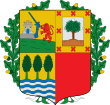Basque Country (autonomous community)
| Basque Country País Vasco (Spanish) Euskadi (Basque) |
|||
|---|---|---|---|
| — Autonomous Community — | |||
| Comunidad Autónoma del País Vasco (Spanish) Euskal Autonomia Erkidegoa (Basque) Autonomous Community of the Basque Country |
|||
|
|||
.png) |
|||
| Coordinates: | |||
| Country | |||
| Capital | Vitoria-Gazteiz | ||
| Government | |||
| - Lehendakari | Francisco Javier "Patxi" López Álvarez (PSOE/PSE-EE) | ||
| Area(1.4% of Spain; Ranked 14th) | |||
| - Total | 7,234 km2 (2,793.1 sq mi) | ||
| Population (2008) | |||
| - Total | 2,155,546 | ||
| - Density | 298/km2 (771.7/sq mi) | ||
| - Pop. rank | 7th | ||
| - Percent | 4.9% of Spain | ||
| ISO 3166-2 | PV | ||
| Anthem | Eusko Abendaren Ereserkia | ||
| Official languages | Spanish and Basque | ||
| Statute of Autonomy | 25 October 1979 | ||
| Parliament | Cortes Generales | ||
| Congress seats | 19 (of 350) | ||
| Senate seats | 15 (of 264) | ||
| Website | Eusko Jaurlaritza/Gobierno Vasco | ||
The Basque Country (Basque: Euskadi; Spanish: País Vasco, IPA: [paˈis ˈβasko]) is an Autonomous Community of northern Spain.
The Basque Country was granted the status of historical region within Spain with the Spanish Constitution of 1978. The capital is Vitoria-Gasteiz (Vitoria is the name in Spanish, Gasteiz in Basque) and Bilbao its largest city.
The autonomous community of the Basque Country should not be confused with the larger Basque Country (Basque: "Euskal Herria") of which it is a component part.
Contents |
Geography
The following provinces make up the autonomous community:
- Álava (Basque Araba), capital Vitoria-Gasteiz.
- Biscay (Spanish Vizcaya, Basque Bizkaia), capital Bilbao.
- Gipuzkoa (Spanish Guipúzcoa), capital San Sebastián.
Features

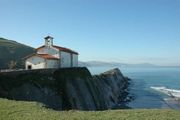
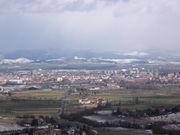
The Basque Country borders with Cantabria and the Burgos province to the west, the Bay of Biscay to the north, France and Navarre to the east and La Rioja (the Ebro River) to the south. The territory has three distinct areas, that are defined by the two parallel ranges of the Basque Mountains. The main range of mountains forms the water divide of the Atlantic and Mediterranean basins. The highest point of the range is in the Aizkorri massif (1551 m). The three areas are:
The Atlantic Basin
Formed by many valleys with short rivers that flow from the mountains to the Bay of Biscay, like the Nervión, Urola or Oria. The coast is rough, with high cliffs and small inlets. The main features of the coast are the Bilbao Abra Bay and the Estuary of Bilbao, the Urdaibai estuary and the Bidasoa-Txingudi Bay that forms the border with France.
The middle section
Between the two mountain ranges, the area is occupied mainly by a high plateau called Llanada Alavesa (Álava plains) where the capital Gasteiz is located. The rivers flow in southern direction from the mountains to the Ebro river. Main rivers are Zadorra and Bayas river.
The Ebro Valley
From the southern mountains to the Ebro, is the so called Rioja Alavesa, that shares the Mediterranean characteristics of other Ebro Valley zones, here is produced part of the Rioja wine.
Climate
The Basque mountains form the water divide and mark also the distinct climatic areas of the Basque Country: The northern valleys, in Biscay and Gipuzkoa and also the valley of Ayala in Álava, are part of the Green Spain, where oceanic climate is predominant, with its wet weather all year round and moderate temperatures. Precipitation average is about 1200 mm.
The middle section has a more Continental Mediterranean climate, but with some influence of the northern oceanic one, this causes dry and warm summers and cold and snowy winters. The Ebro valley has a pure Continental Mediterranean climate, winters are cold and dry and summers very warm and dry, with precipitation peaking in spring and autumn. Precipitation is scarce and irregular, as low as 300 mm.
Demography


Almost half of the 2,155,546 inhabitants of the Basque Country live in Greater Bilbao, Bilbao's metropolitan area. Of the ten most populous cities, six form part of Bilbao's conurbation (Bilbao, Barakaldo, Getxo, Portugalete, Santurce and Basauri).
At 28.2% of the Basque population born outside this region,[1] immigration is crucial to Basque demographics. Over the 20th century most of this immigration came from other parts of Spain, typically from Galicia or Castile-Leon. Over the last years, sizeable numbers of this population have returned to their birthplaces whereas immigration to the Basque country currently originates abroad, chiefly from South America.[1]
Major cities
- Bilbao (354,145)
- Vitoria-Gasteiz (226,490)
- San Sebastián (183,308)
- Barakaldo (95,675)
- Getxo (83,000)
- Irun (59,557)
- Portugalete (51,066)
- Santurtzi (47,320)
- Basauri (45,045)
- Errenteria (38,397)
Languages
Spanish and Basque are co-official in all territories of the Community.
The 2006 sociolinguistic survey[2] of all Basque provinces showed that in 2006 of all people aged 16 and above in the Basque Autonomous Community, 30.1% were fluent Basque speakers, 18.3% passive speakers and 51.5% did not speak Basque. The percentage was highest in Gipuzkoa (49.1% speakers) and lowest in Álava (14.2%). These results represent an increase on previous years (29.5% in 2001, 27.7% in 1996 and 24.1% in 1991). The highest percentage of speakers can now be found in the 16-24 age range (57.5%) vs 25.0% in the 65+ age range.
History

This section is about the history of the Autonomous Community since 1978. See also History of the Basque people
Before the Spanish Constitution of 1978 and its system of autonomous communities, these three provinces were known in Spanish as the Provincias Vascongadas. The political structure of the new autonomous community is defined in the Gernika Statute, which was approved by a majority in a referendum held on 25 October 1979. Nowadays it is one of the most decentralized regions in the world, in this regard it has been quoted as having "more autonomy than just about any other in Europe"[3] by The Economist.
In 2003, the governing Basque Nationalist Party proposed to alter this statute through the Ibarretxe Plan. The project, though approved by majority in the Basque chamber, was finally rejected by a large majority in the Madrid Cortes Generales on the grounds that it contradicts the Spanish Constitution.
In this regard, Basque nationalists cite the fact that in the 1978 Spanish Constitution referendum, which was passed with a majority of votes in the Basque Country, the Basque Country had the highest abstention[4] (the Basque Nationalist Party had endorsed abstention on the grounds that the Constitution was being forced upon them without any Basque input). To this, the "no" vote in this referendum was also higher in the Basque Country than in the rest of the state. All in all, many Basques believe that they are not bound to a constitution that they never endorsed.
On May 5, 2009, after thirty years of nationalist government, the Lehendakaritza (Basque presidency) was transferred to Patxi López, from the Basque Socialist Party, after an unprecedent agreement with the conservative Popular Party.[5] after a very controversial election, with more than 100,000 votes coming from the illegalised Basque leftist nationalists considered void.
Economy
The Basque Autonomous Community is currently the wealthiest region in Spain, with gross domestic product (GDP) per capita being 40% higher than that of the European Union and 33.8% higher than Spain's average in 2008, at €31,712 EUR.[6] Industrial activities were traditionally centered on steel and shipbuilding, mainly due to the rich iron ore resources found during the 19th century around Bilbao. The Estuary of Bilbao was the center of the Basque Country's industrial revolution during the 19th and the first half of the 20th century. These activities decayed during the economic crisis of the 1970s and 1980s, giving ground for the development of the services sector and new technologies.
Today, the strongest industrial sectors of the Basque Country's economy are machine tool, present in the valleys of Biscay and Gipuzkoa, aeronautics in Vitoria-Gasteiz and energy, in Bilbao.
The main companies in the Basque Country are: BBVA bank, Iberdrola energy company, (both of them have their headquarters in Bilbao) Mondragón Cooperative Corporation that is the largest cooperative in the world, Gamesa wind turbine producer and CAF rolling stock producer.
In 2009 and during the financial crisis the Basque Country outperformed Spain as a whole. Unemployment in the Basque country is roughly 10%, a percentage in line with the EU average. Spain as a whole is the country with the highest unemployment rate in the European Union, at 19.5%. In the last quarter of 2009 unemployment went down by 3,500 people. Spain's unemployment went up by over 100,000 people in the same period.
In regards to GDP performance, Q4 meant that the Basque Country was out of recession with a 0.2% growth. The Spanish economy as a whole remained in recession after Q4.
During 2009 the Basque economy contracted by -3.3% compared to a -3.6% in the rest of Spain.
Transport
The strategic geographical location of the Basque Country as a link between the northwest and centre of Spain and the rest of Europe makes this territory a very transited one.
Road
The main backbones of road transport are the AP-8 motorway that links Bilbao, San Sebastián and the French border and the A-1 motorway that links San Sebastián and Gasteiz with central Spain. Other important routes include the AP-68 motorway that links Bilbao with the Mediterranean.
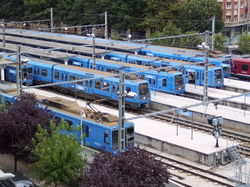
Rail
Eusko Trenbide Sarea (Basque Railway Network) is the Basque Government owned company that maintains and creates the railway infrastructure in the autonomous community.
EuskoTren (Basque Train) is the Basque Government owned narrow gauge rail company that operates commuter services in Bilbao and San Sebastián, intercity Bilbao-San Sebastián service, and EuskoTran tram services in Bilbao and Vitoria-Gasteiz.
Metro Bilbao is the company that operates the two metro lines that serve Greater Bilbao.
The Spanish government owns two main RENFE broad gauge lines that link Gasteiz with San Sebastián and Bilbao with central Spain. It also operates Cercanías commuter lines in both Bilbao and San Sebastián.
FEVE narrow gauge company operates a commuter line between Bilbao and Balmaseda and links Bilbao with the rest of northern Spain.
A new high speed network (called Basque Y) is under construction, that will link the three capitals in 'Y' form. It is scheduled to be completed in 2013, including a connection with the French TGV network in Hendaye. Because of the rough geography of the territory, most of the network will run through tunnels.
Airports

The three capitals have airports:
- Bilbao Airport {BIO} International.
- Vitoria Airport {VIT}.
- San Sebastián Airport {EAS}.
Of the three, the most important hub and entry point to the Basque Country is Bilbao Airport, offering many international connections and through which moved over 4,200,000 passengers in 2007.
Seaports
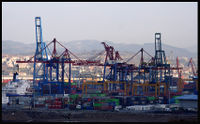
The two most important ports are the Port of Bilbao and the Port of Pasaia. There are other minor fishing ports like Bermeo and Ondarroa.
The Port of Bilbao is by far the most important of the Basque Country and the north of Spain, being the fourth most important in Spain with over 38 million tons of traffic.
All the cruising routes arrive to Bilbao, there is a ferry service that links Bilbao with Portsmouth (United Kingdom).
Cuisine

Basque cuisine is an important part of Basque culture. According to the chef Ferran Adrià, San Sebastian "in terms of the average quality of the food, in terms of what you can get at any place you happen to walk into, maybe it is - probably it is, yes - the best in the world."[7] The most popular dishes there are the seafood, fish (for example Marmitako) and the "Pintxos", bar finger food. Basque food is one of the reasons for tourism to the Basque Country, especially the "pintxos". A frequent way to socialize is "ir de pintxos" or txikiteo, Basque version of pub crawl.
Politics
Government

The current laws configure the autonomous community as a federation of the three constituent provinces, which had been ruled locally since their incorporation to Castile in 1200 by their own laws and institutions in what is known as the Foral System. These autonomous regimes, similar to the one for Navarre, were curtailed in the 19th century, largely suspended under Franco, but restored by the Spanish Constitution of 1978.
The post-Franco Spanish Constitution of 1978 acknowledges "historical rights" and attempts compromise in the old conflict between centralism and federalism by the establishment of autonomous communities (e.g. Castile and Leon, Catalonia, the Valencian Community, etc). The provincial governments (diputación foral) were restored only in the Basque Country and Navarre, but many of their powers were transferred to the new government of the Basque Country and Navarra autonomous communities; however, the provinces still perform tax collection in their respective territories, coordinating with the Basque, Spanish and European governments.
Under this system the Diputaciones Forales (Basque: Foru Aldundiak) administer most of each of the provinces but are coordinated and centralized by the autonomous Basque Government (Spanish Gobierno Vasco, Basque: Eusko Jaurlaritza).
.jpg)
The seats of the Basque Parliament and Government are in Vitoria-Gasteiz, so this is the capital city de facto, but the Basque Autonomous Community has no capital de iure.[8][9] The Parliament is composed of 25 representatives from each of the three provinces. The Basque Parliament elects the Lehendakari (President) who forms a government following regular parliamentary procedures. Until 2009 all Lehendakaris (even those in 1937 and during the exile) have been members of the Basque Nationalist Party (Euzko Alderdi Jeltzalea) (moderate and Christian-Democrat) since 1978. Despite their continued leadership role, they have not always enjoyed majorities for their party and have needed to form coalitions with either Spain wide parties or left-leaning Basque nationalist parties, often governing in a difficult minority position.
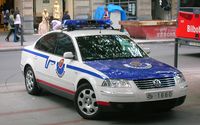
The former government was led by Juan José Ibarretxe (Euzko Alderdi Jeltzalea) and supported also by left-leaning nationalists of Eusko Alkartasuna (Basque Solidarity) and Communist-dominated Ezker Batua (United Left).
Both non-regional parties, Partido Socialista de Euskadi (federated to the Spanish Socialist Workers' Party) and Partido Popular (People's Party) reached an agreement in the votation for new president and Patxi López was elected as Lehendakari on May 5, 2009, ending a thirty year nationalist predominance.
The autonomous community has its own police force (the Ertzaintza), controls the education and health systems, and has a Basque radio/TV station. These and other powers have since 1980 been transferred to the Autonomous Community by the Cortes Generales under the Gernika Statute.[10]
Territorial claims

The statute provides for mechanisms for neighbour Navarre, which also has a Basque ethnic background and is claimed as the core of the nation by Basque nationalists, to join the three western provinces if it wishes to do so. The Basque Government used the "Laurak Bat", which included the arms of Navarre, as its symbol for many years. Navarre protested, and tribunals ruled in their favour. The Basque Government replaced it with an empty red field.
Navarre is just one of the territories that the Basque nationalist parties claim as Basque territory; there are also two enclaves surrounded by Basque territory—Treviño (Basque: Trebiñu) and Valle de Villaverde (Basque: Villaverde-Turtzioz)—which belong to the fellow neighbouring communities of Castile and León and Cantabria respectively.
See also
References
- ↑ 1.0 1.1 "El 28,2% de la población que vive en el País Vasco ha nacido fuera | País Vasco". elmundo.es. http://www.elmundo.es/elmundo/2009/03/11/paisvasco/1236769219.html. Retrieved 2010-04-26.
- ↑ IV. Inkesta Soziolinguistikoa Gobierno Vasco, Servicio Central de Publicaciones del Gobierno Vasco 2008, ISBN 978-84-457-2775-1
- ↑ "Spain and its regions | Autonomy games". Economist.com. 2007-09-20. http://www.economist.com/world/europe/displaystory.cfm?story_id=9833306. Retrieved 2010-04-26.
- ↑ "Archivo de Resultados Electorales". .euskadi.net. http://www9.euskadi.net/q93TodoWar/q93Desplegar.jsp. Retrieved 2010-04-26.
- ↑ http://www.elcorreodigital.com/vizcaya/20090505/mas-actualidad/politica/lopez-vuelve-tender-mano-200905051910.html El Correo May 6, 2009 (in Spanish)
- ↑ http://www.eustat.es/elementos/ele0002100/ti_GDP_per_capita_by_province_Current_prices_base_2005__1980-2008a/tbl0002160_i.html
- ↑ Carlin, John (2005-03-13). "Is San Sebastián the best place to eat in Europe?". The Observer. http://www.guardian.co.uk/lifeandstyle/2005/mar/13/foodanddrink.shopping2. Retrieved 2010-09-09.
- ↑ "Azkuna: «Vitoria no es la capital de Euskadi»". El Correo. 2010-03-12/. http://www.elcorreo.com/vizcaya/v/20100312/politica/vitoria-capital-euskadi-20100312.html. Retrieved 2010-09-09.
- ↑ Ayala, Alberto (2010-05-11). "Vitoria no será capital por ley, por ahora". El Correo. http://www.elcorreo.com/alava/v/20100511/politica/vitoria-sera-capital-ahora-20100511.html. Retrieved 2010-09-09.
- ↑ [1]
External links
|
|||||||||||||
|
|||||||

